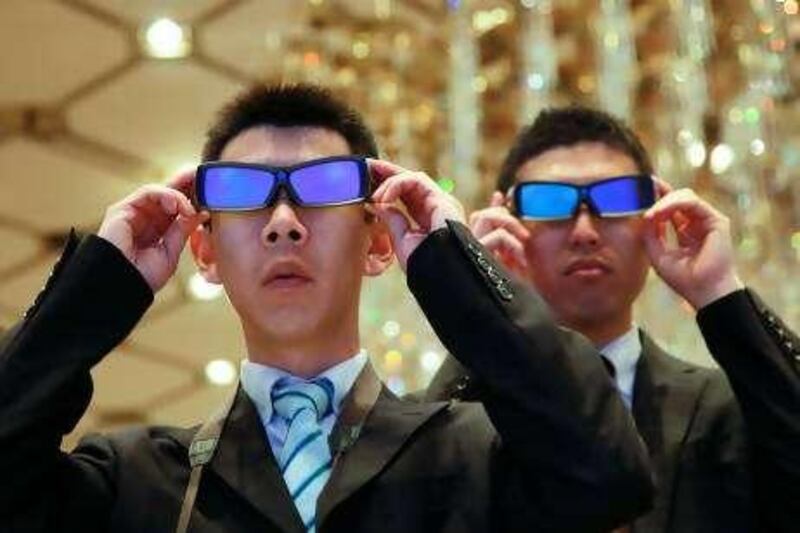Electronics firms are pushing 3D television like never before - but they could well be looking through rose-tinted glasses when it comes to consumer demand for the special TV sets, according to UAE shoppers. While a recent survey from Nielsen found that consumers in this region had the highest levels of interest in 3D television, many shoppers in the UAE say they still have serious reservations over buying the televisions, which require users to wear glasses to view 3D programmes.
With top-of-the-range models costing Dh17,500, the high price of 3D TVs was cited by consumers as a major deterrent to purchasing one. For example, LG's 47-inch LED 3D television costs Dh10,499 - almost double the cost of its 47-inch LED-LCD model, which retails at Dh5,799. Other issues include the meagre choice of films and TV programmes available in 3D, the annoyance of wearing glasses to view the programmes, and the concern that the technology is just "a gimmick".
This is despite the findings of Nielsen's "How People Watch" report, published last month, which found that consumers in the Middle East, Africa and Pakistan region were more than twice as likely to own or be interested in buying a 3D set compared with those in Europe and North America. The level of interest in 3D TV was highest in Saudi Arabia out of all the 55 countries surveyed, while the UAE ranked 10th on the list.
Worldwide, just 12 per cent of consumers in the online poll said they own or have definite interest in purchasing a 3D TV. "While that may not seem like much, compared to some other emerging technology, this represents a sizable opportunity to attract the eyeballs and investment of some of the world's most affluent TV households," said the Nielsen report. But UAE-based shoppers polled by The National appear to reflect the opinion of their American counterparts, who have doubts about 3D TV. According to a separate Nielsen report published last week, US consumers like the experience of 3D television, but are put off by the high cost of the sets and having to wear special glasses. More than half the US consumers polled by Nielsen said the 3D glasses were a "hassle", and 57 per cent said they were "not likely" to buy a 3D TV set because of this.
Grant Latham, 53, an expatriate from New Zealand living in Dubai, says that the price of 3D sets is the main deterrent for him. Mr Latham says he is looking to buy a widescreen TV in the range of Dh3,000 to Dh4,000. Pointing to a 46-inch Samsung 3D television, selling for Dh11,599 in the Sharaf DG electronics shop in Dubai Mall, he says the additional cost of 3D models is prohibitive. "I wouldn't pay that much for a TV - I don't think the television in the UAE is good enough to warrant that expense. I'm more interested in [regular] widescreen models," says Mr Latham.
Pete Millar, 52, an expatriate visiting Dubai who works in Baku in Azerbaijan, says the special glasses would put him off buying a 3D TV set. "Would I consider buying a 3D model? Probably not. I wear glasses already - having to wear another pair on top doesn't really appeal," he says. While Mr Millar says that he enjoyed 3D films such as James Cameron's Avatar, he thought that the limited amount of other 3D productions were often "not true 3D" because they were not originally shot in the format. "There's no programming for it," he says. "So what are you buying it for? The occasional movie?"
Other UAE-based consumers agree that 3D is more of an "occasional" experience. "It's a nice experience to watch a movie, but it's very difficult to use on a daily basis. You have to wear glasses and it's not very comfortable," says Waseem Hattar, 26, from Jordan. Dion Smith, 29, originally from Malta, says "3D is a bit of a gimmick". Paul Dodds, 36, a British expatriate living in Dubai, says he is also looking to buy a new TV - but agrees that the prices of 3D sets are just too high for him to consider buying one.
"3D is a great idea, but is ultimately way too expensive. I'd be much happier waiting about a year, when the price will come down by one third," says Mr Dodds. While Mr Dodds believes 3D TV is "gimmicky like anything else", he says the lack of programming is a more serious concern. But he dismisses the fears held by some that viewing 3D shows through the special glasses could pose a health risk. Some studies have suggested that 3D television could trigger seizures or strokes in people with a family history of those conditions.
Mr Dodds says he feels reassured because the sets would have been "stringently" tested. "I'm not concerned about it, but I'd think you'd get eye strain after a while," he says. But Mr Dodds acknowledges that, with lower prices and greater level of acceptance among consumers, the 3D format could be more popular in the future. "In three to five years' time, it'll probably be the only way to watch telly," he says.
@Email:bflanagan@thenational.ae






